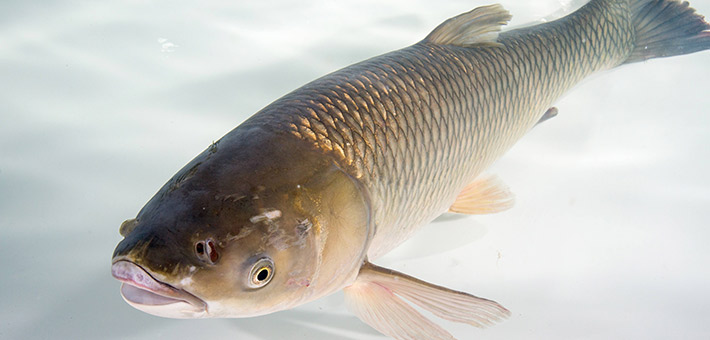Invasive grass carp captured in the Tittabawassee River
April 14, 2020
Contact:Lucas Nathan, NathanL@Michigan.gov, 517-284-6235

An adult grass carp. Photo by Ryan Hagerty/USFWS.
During a routine fish survey in the Tittabawassee River below the Dow Dam in Midland County on March 17, Michigan Department of Natural Resources staff captured an invasive grass carp. The Tittabawassee River flows into Saginaw Bay in Lake Huron. Lab testing determined that the fish was diploid, or capable of reproducing. This is the first documented capture of a diploid grass carp in Lake Huron.
Following the capture, the DNR implemented a response action on March 23, before the “Stay Home, Stay Safe” Executive Order was issued. The DNR used electrofishing boats in and near where the fish was caught. No additional grass carp were captured or observed. Additional response efforts were halted due to COVID-19 public health and safety advisories.
The DNR will work with partners from tribal agencies, the province of Ontario, and U.S. and Canadian agencies in developing plans to conduct additional surveys in the Tittabawassee River and connected waterways when the 2020 field season resumes.
Using ear bones, or otoliths, an analysis will be performed to determine if the grass carp was produced in Great Lakes waters or if it was of aquaculture origin. The results are not expected to be available until this summer.
Grass carp have been prohibited in Michigan for nearly 50 years. Since 1989, only 13 grass carp captures have been documented in Lake Huron waters. Of the fish that were tested for reproductive status, all were sterile. The known captures include a grass carp caught by a recreational angler in the Tittabawassee River in 2013.
The DNR annually conducts several fish assessment surveys in the Tittabawassee River and Saginaw Bay and to date has caught just one grass carp in these waters, suggesting that the likelihood of additional grass carp captures is low.
In recent years, most grass carp captures have been from Lake Erie and its tributaries. No grass carp have been captured in Lake St. Clair. Recent studies have documented successful grass carp spawning in the Sandusky and Maumee rivers, both tributaries of Lake Erie.
Because Lake Erie is the likely source of grass carp movement into Lake Huron, multiagency intensive survey and capture efforts will continue in Lake Erie waters in 2020.
More information on invasive grass carp is available at Michigan.gov/InvasiveCarp.
Michigan's Invasive Species Program is cooperatively implemented by the Department of Environment, Great Lakes, and Energy, the Department of Natural Resources and the Department of Agriculture & Rural Development.
